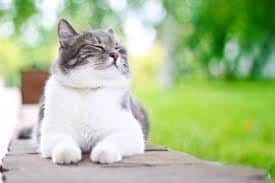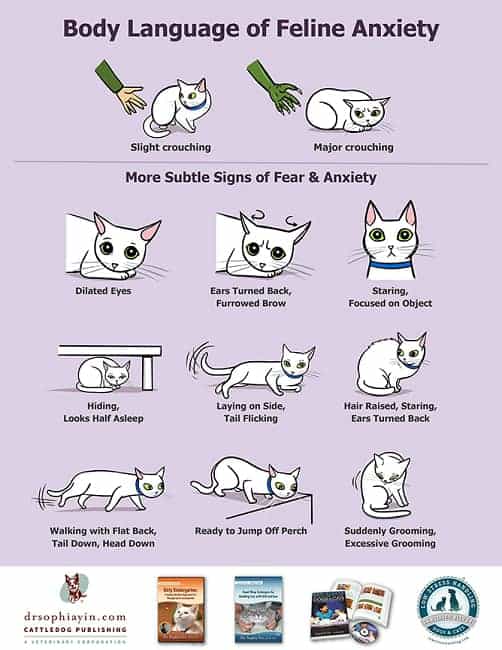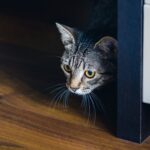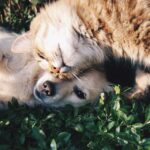Cat body language and expression may be obvious cat to cat, but often the subtle postures are lost on us humans. Understanding what you cat is trying to convey can be very important.
This review attempts to help de-mystify your cat’s body language when he or she is stressed, frustrated, scared as well as when they are feeling happy and playful.

Cats use body language to communicate a variety of information and emotions to others. The primary body parts they use to convey their state of mind are their ears, tail, eyes, body posture, and vocal cords. Types of emotions and behaviors that can be demonstrated are fear or anxiety, frustration, pain, play, mating, contentedness or relaxation, and curiosity. Often body language can be used to display multiple emotions. Thus, when trying to figure out your cat’s body language, try to understand the context in which he is communicating.
Fear/Anxiety Avoidance
These types of behaviors are an effort to maintain safety from a perceived threat by avoiding the threat.
- freezing (in an effort to be less noticeable), especially if confined or unable to escape; such cats are often quiet and do not vocalize or make noise. Note that a “frozen” cat can switch quickly to “repulsion,” becoming aggressive towards the cause of fear
- freezing results in stopping other normal behaviors like eating or using the litterbox; this is why cats wait until quiet hours to eat/drink when a lot of commotion is happening at home
- moving away slowly, i.e., crawling or slinking away
- fleeing, especially if startled
- hiding
- crouched body with feet flat on the ground (often underneath the cat) to allow for quick escape and protect important organs
- trembling
- tensed muscles
- dilated pupils (enlarged black part of the eyes)
- ears turned back or flattened with brow furrowed
- sleepy appearance
- walking with back flat, tail down, and head down
- excessive and sudden grooming in one area
- standing tall with hair standing on end (an effort to appear larger)
- tail held tightly to the body
- averting the eyes
Fear/Anxiety Repulsion
These types of behaviors are an effort to maintain safety from a perceived threat by getting rid of it.
- hissing, growling
- swiping
- spitting
- scratching
- biting
- directly and intensely staring at the source of anxiety
- using the body to physically block another being (eg, blocking another being from the food bowl if worried about that resource)
- ears flattened and out to the side
- standing tall with hair standing on end (an effort to appear larger)
Fear/Anxiety/Curiosity
These information-gathering behaviors are an effort to learn about an object, person, environment, and/or if perceived as a threat, to determine the severity.
- hypervigilance and scanning the surroundings frequently
- fixation on the object of concern
- ears erect and directed at the source of concern
- sniffing
- Flehmen response, which is raising or curling the lips to detect information such as pheromones
- may startle easy if intensely focused
- tail swishing
- straight legs and upright posture
- watching object of interest casually/calmly (as opposed to the intense staring of repulsion)
Frustration
These types of behaviors are reactions to something that is not meeting the cat’s expectations or their inability to control something (e.g., hunger, not wanting to be held). These behaviors are an effort to achieve what they desire.
- vocalization- meowing continuously
- circling or pacing
- rubbing body or face on people, animals, or objects
- scratching on objects
- cats may switch behaviors quickly (unlike with fear/anxiety, where in some cases behaviors are prolonged)
- very active
- flattening or rotating ears
- thrashing or firm swishing of tail
- gazing upward
- half-blinking
- showing the tongue
- Flehman response
- nose licking or nose wrinkling
- rippling and twitching skin
- hair standing up if very frustrated
- grooming specific areas (eg, shoulder or base of tail) quickly and in an intense manner
Pain
It is extremely difficult to notice pain in cats as they tend to hide pain well, but they do demonstrate some noticeable behaviors.
- hiding
- limping
- more withdrawn or quiet
- ears back
- pupils dilated
- change in normal behavior
- squinted eyes
- hunched back
Play
These behaviors are used during play and to initiate it. Hunting behaviors are similar to those of play.
- ears forward
- tail pointed up (an indicator that the cat is game for a friendly interaction)
- whiskers forward
- tail twitching
- predatory/hunting behavior such as stalking, pouncing, swiping, or biting
- immature cat rolling towards older cat (an indication of appeasing behavior)
Relaxed/Content
These show the cat is content and often demonstrates trust in their environment.
- eyes half-closed
- sitting or lying down with minimal muscle tension
- minimal tail movement
- purring
- kneading (“making biscuits”)
- rubbing on people or things
- belly exposed (demonstrates trust because cats will often protect their belly in fearful situations)
- grooming the body rhythmically, in a relaxed manner
Mating
These are an effort to demonstrate receptiveness to mating, such as showing signs of going into heat or estrus.
- female rolling around a male
- purring
- stretching
- rubbing on objects, people, or other animals
- extra affection
- raising hindquarters, treading with back legs
- frequent and loud vocalizations
- backing up to furniture or horizontal object, twitching tail, often urinating in this position (marking behavior).
Here is a chart by behaviorist Dr. Sophia Yin that illustrates feline anxiety:



